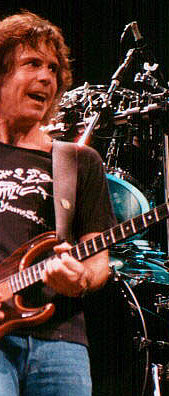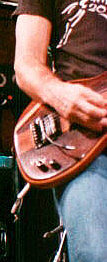 |
||||
 |
 |
 |
||
 |
||||
 |
||||
Is that when Mother McCree's Uptown Jug Champions got started?
Yes, and we dove into it pretty deep. We got a bunch of old jug band, country blues, and "race" records that a friend's mother had collected, and I took them over to Garcia's house where we tried to figure out the words and chords. We actually got a fairly thorough under- standing of what that kind of music was about. That was pretty hot little jug band for a while.
What
was the instrumental breakdown of the band?
One
or two guitars, mandoline, sometimes a banjo. Pigpen played harmonica
and the "foot crasher," which was a hi-hat cymbal. I played
guitar, jug, and washtub bass. Then we had a great big box full
of rhythm instruments and kazoos and stuff like that. It was a pretty
fun little outfit, and we endeavored to come up with a novel approach
to each song we performed. That really established our working relationship
as a band. We stayed together as that band for more than a year.
Is
that when you decided to electrify your instruments?
Yes.
The Beatles had come out and made it real
big, and then the Stones came out and they made it real big. The appeal of electic music just started creeping in, and by the end of the year, I was working at Dana Morgan Music too - sort of taking some of Garcia's excess students and picking up a few of my own. I was also working at another music store in Menlo Park, and we had access to electric instruments. So we give in to the temptation to try a little rock and roll. Garcia had done a few electric gigs with Pig in a band called the Zodiacs before I'd ever known them, and so they had a little experience with R&B and stuff like that. Pig knew it very well, because his father had been a DJ at a black R&B station, so we had a leg up there. We just sort of evolved into a rock and roll band. Dana Morgan, Jr., played bass, which ensured that we got to use the instruments and amplifiers that we otherwise couldn't have afforded. That's when we became the Warlocks.
How
did Phil Lesh get involved?
We started to get a following pretty quickly around
the mid-Peninsula and were getting a lot of gigs. Dana couldn't
keep up with the music store and the band, and so Phil - who was an old
friend of Garcia's - came down to listen one night and we mutually decided
that he could play bass with a little practice. He had never played
bass, but he'd seriously studied classical music and was a trumpet player. He
wood shedded for a couple of weeks and got good enough to hold down the
low end and eventually, of course, became a hell of a bass player. Bill
Kreutz-mann had been a drum student at the music store, so that's where
he came from. At the time we became the band that made up the Grateful
Dead, although we didn't actually change the name for a couple of months.
What
were your first guitars?
My
first was a $17 Japanese model. Then I got a $35 Harmony classical,
and it was okay. When I was 15, I ran away from home to cowboy for
a summer and make enough money to buy a Martin D-28 from a pawn-shop.
A little later I found a really nice 1944 Martin 000-21 in a pawnshop
for less than $100, as I recall. Those were the old days.
I played that until I got my first electric, which was a Gretsch Chet
Atkins model. Then I got a Gibson ES-335, and later on tried
a Rickenbacker, which was a great little guitar. From about 1968
to '71 I used a Gibson ES-345, until I switched to a Gibson SG. I
had been playing that for about three years when I met Jeff Hassleberger
from Ibanez. We hit it off real well and started working on desingning
a guitar. It was about 1975 when I got my first Ibanez guitar, and
it's pretty much a continuing progression of them ever since. They
all look the same, but they're real different.
In
what ways are they different?
Well, the way it started was Jeff showed me a
double-neck guitar they had built, and I really liked the way the G
string sounded. The first guitar we made was blonde and sort of
a cut-down version of the double-neck. There were a number of pictures
of me playing the guitar in the Ibanez ads inside the cover of Guitar
Player magazine in late '76 and '77. That was the original Bob Weir
model. Then around 1977 Jeff and I sat down with French curves
and designed another body styel. I've always liked the look of Martin
000 guitars, so we kind of styled the bottom and the waist of it after
them. We just played with French curves until we found something
we liked for the cutaways. I guess it came out looking sort of reminiscent
of a Gibson ES-345. We played around with a sliding, height-ad-justable
middle pickup on three of the prototypes until I realized, at one point,
that I hadn't moved the pickup for several months. I really had
found where it worked best in combination with the other pickups, so we
just fixed it in place. From ther it's just been a matter of refinements
in the bridge and electronics and things like that.